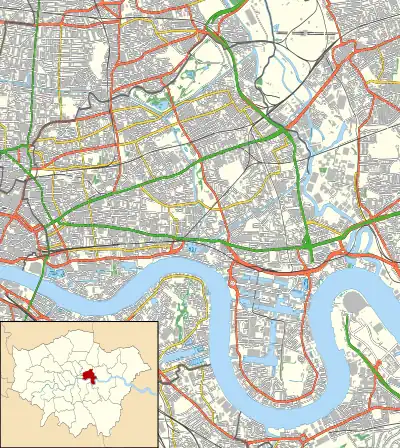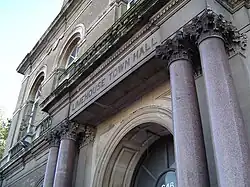Limehouse Town Hall
Limehouse Town Hall is a former town hall building on Commercial Road, in Limehouse, in the London Borough of Tower Hamlets. It is a Grade II listed building.[1]
| Limehouse Town Hall | |
|---|---|
 Limehouse Town Hall | |
| Location | Commercial Road, Limehouse |
| Coordinates | 51°30′43.56″N 0°1′53.22″W |
| Built | 1881 |
| Architect | Arthur and Christopher Harston |
| Architectural style(s) | Palazzo style |
Listed Building – Grade II | |
| Designated | 27 September 1973 |
| Reference no. | 1240047 |
 Shown in Tower Hamlets | |
History

The building was commissioned by the Limehouse Board of Works as a vestry hall for the benefit of the Parish of St Anne's.[2] The site selected by the vestry had previously been occupied by a private residence belonging to a Mr. Walter.[3][2]
The foundation stone for the building was laid by the churchwarden, James Rollinson, on 21 October 1879.[4] The building was designed Arthur and Christopher Harston in the Palazzo style[5] and built by J. H. Johnson[2] and was opened as the vestry hall of the Limehouse District on 29 March 1881.[4] The design involved a symmetrical main frontage with five bays facing onto Commercial Road; the central section featured a portico flanked by Corinthian order columns and a balcony above; there were round headed windows on the first floor and a carved pediment above.[1] The principal rooms were the council chamber on the ground floor and an assembly room on the first floor.[4]
After the civil parish became a part of the Metropolitan Borough of Stepney in 1900,[6] the town hall ceased to be the seat of local government and was used as an events venue and administrative centre.[7]
On 30 July 1909 the Chancellor of the Exchequer David Lloyd George made a polemical speech in the assembly room, attacking the House of Lords for its opposition to his "People's Budget". This speech was the origin of the phrase "To Limehouse", or "Limehousing", which meant an incendiary political speech.[8] The building was badly damaged in the Blitz during the Second World War but was subsequently restored and re-opened by the Prime Minister, Clement Attlee, in November 1950.[5]
Responsibility for management of the building was transferred to the London Borough of Tower Hamlets in 1965 and it was re-opened as the National Museum of Labour History by the Prime Minister, Harold Wilson, in May 1975.[2] After the museum got into financial difficulties and then closed in 1986, the building served as the Wapping Neighbourhood Offices until 1994, when it became a training centre and winter shelter for homeless people.[9]
The building was placed on English Heritage's list of buildings at risk in 2003[7] but, after the Limehouse Town Hall Consortium Trust was formed and secured a long lease on the building in 2004, the building was restored with support from English Heritage[10] and re-opened as a community centre in April 2012.[7]
Features and current use
The building has a number of offices located on the ground floor below the assembly room.[7] It has been home to several groups, such as the Space Hijackers, the Voice Refugee Forum[11] Stitches in Time, the University of Openess, Twenteenth Century and the Boxing Club[12] (this is no longer a boxing club, but a group that hires spaces and arranges occasional events, mostly to raise money for the upkeep of the venue),[13] and some self-help bicycle maintenance workshops.[14] The building is not generally open to the public, but participates in Open House London for guided tours of the building.[5]
References
- Historic England. "Limehouse Town Hall, Tower Hamlets (1240047)". National Heritage List for England. Retrieved 13 December 2008.
- "Limehouse Town Hall Archives". A London Inheritance. Retrieved 9 April 2020.
- "Ordnance Survey Map". 1873. Retrieved 9 April 2020.
- "London's Town Halls". Historic England. p. 184. Retrieved 25 April 2020.
- "Limehouse Town Hall". Open House London. Archived from the original on 18 June 2020. Retrieved 9 April 2020.
- Youngs, Frederic (1979). Guide to the Local Administrative Units of England. Vol. I: Southern England. London: Royal Historical Society. ISBN 0-901050-67-9.
- "Limehouse Town Hall springs back to like after leaky roof is fixed". East London Advertiser. 12 April 2012. Retrieved 9 April 2020.
- "Limehousing". Take our word for it. 24 January 2000. Retrieved 10 May 2007.
- "Limehouse Town Hall". Limehouse Town Hall Consortium Trust. Archived from the original on 22 October 2005. Retrieved 9 April 2020.
- "EH comes up with cash to save East End town hall". Architects Journal. 9 October 2006. Retrieved 15 November 2020.
- "Instiutional Racism in the Left". Retrieved 10 December 2021.
- "Creative Residents". Limehouse Town Hall. April 2015. Retrieved 10 December 2021.
- "The Boxing Club". Retrieved 9 April 2020.
- "Bicycle Maintenance Workshop". Tower Hamlets Wheelers. Retrieved 9 April 2020.